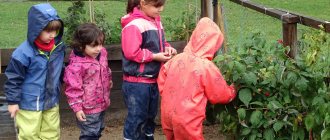Goals of patriotic education of preschool children
- the formation of a system of children’s knowledge about their homeland, which can be presented as follows: Natural geographic information (geographical features of the Motherland, climate, nature of the country), information about people’s lives (features of life, work, culture, traditions), social information (knowledge of attractions hometown, capital, country, knowledge of the name of the country, its capital, other cities, state symbols), some historical information (about the lives of people in different historical periods, about the exploits of people during the Great Patriotic War, knowledge about the historical monuments of the city, streets) .
- nurturing preschoolers’ interest in the world around them and emotional reactions to events in public life.
It involves the activation of the emotional sphere of the individual, the formation of such feelings as love for native and close people, hometown, respect for the history of the people, admiration for works of folk art, love for nature, hatred of enemies.
Involving children in practical activities to apply acquired knowledge. This requires the development of certain abilities and skills in children: the ability to reflect accumulated knowledge in play, art and work activities, the ability to participate in socially oriented work, the ability to take care of nature and the results of the work of others, the ability to reflect knowledge in language, communication with adults and peers .
When solving the problems of patriotic education, each teacher must build his work taking into account local conditions and the characteristics of children, taking into account the following principles:
- “Positive centrism” (choice of knowledge that is most relevant for a child at a certain age);
- continuity of the pedagogical process and subsequent activities
- differentiated approach to each child with maximum consideration of his psychological characteristics, abilities and interests
- a meaningful combination of different types of activities and an age-appropriate balance of intellectual, emotional and motor activity;
- Activist approach;
- the nature of education based on children's activity.
Features of the formation of patriotism in preschool children
The main stage in the formation of patriotism in children should be considered the accumulation of social experience of life in their homeland and the assimilation of the norms of behavior and relationships accepted there.
The concept of patriotism includes cognitive (knowledge, ideas), emotional (feelings) and behavioral components (skills, abilities), which are realized in the sphere of society and nature.
The cognitive component provides the content of patriotic education.
The behavioral component performs a diagnostic function.
The emotional component is in the lead at this age.
Feelings play a certain role in the patriotic education of children, but the moral feelings of preschoolers are characterized by specificity, insufficient strength and stability.
Preschoolers' ideas gradually expand. A system of generalized knowledge about the phenomena of social life is formed only at the end of higher preschool age. This is facilitated by the mastery of moral judgments, assessments, concepts, as well as children’s cognitive interest in the world around them.
A characteristic feature of raising children in the spirit of patriotism is the unity of moral feelings and knowledge.
Knowledge influences the moral development of a child only when it is colored by feelings and experiences. A feature of the manifestation of patriotism in preschool children is that moral experience is limited to the practical activities in which they are involved (communication with children and adults, work).
In preschool age, the formation of will and moral ideals, which are important for patriotic education, begins.
Contents of work on getting to know children’s hometown.
The work of nurturing love and affection for one’s own city requires enormous support for the child’s cognitive sphere, his imagination and memory.
In the basic program “Proleska. Education and training of preschool children" states that a four-year-old child should know the name of his street and the name of the street on which the kindergarten is located.
The attention of older children should be paid to objects located on the nearest streets: School, cinema, post office, pharmacy, etc. They talk about their purpose, emphasizing that all this was created for the convenience of people.
The range of objects with which older preschoolers are introduced. expanded - this is the area and the city as a whole, its attractions, historical places and monuments. This is explained by the children in whose honor they are erected.
An older preschooler should know the name of his city, his street, adjacent streets and in honor of whom they are named. They explain to him that every person has a hometown and the city in which he was born and lives. This requires travel to the city and the countryside.
Adults should talk about the city and show it. It is necessary to show the child that his hometown is famous for its history, traditions, sights, monuments, and best people. Children and adults travel around the city. Sometimes excursions are organized by the kindergarten. Adults tell children about their favorite places.
A kindergarten teacher can give lectures about monuments, theaters, etc. It is important that the educational material is understandable to children and arouses their interest. It is necessary that children take part in the celebration of the city day. Their impressions should be reflected in the drawings and designs. You can make gifts for the holiday.
The range of objects that older preschoolers become acquainted with is expanding - this is the region and the city as a whole, its attractions, historical places and monuments. The children are told in whose honor they were erected. An older preschooler should know the name of his city, the street and adjacent streets after which they are named. He is taught that everyone has a hometown and a city in which he was born and lives. To do this, they need to travel to the city, visit nature, watch adults at work and learn that work unites people, requires them to be united, mutually assisted, and knowledgeable about their activities. And here it is of great importance to familiarize children with the folk crafts of the region, with folk craftsmen.
To instill in children a love for their city, it is necessary to let them understand that their city is part of the Motherland, because all places, large and small, have much in common.
-Wherever people work for everyone (teachers teach children; doctors treat the sick; workers make cars, etc.);
-Wherever traditions are respected: The Motherland remembers the heroes who defended it from enemies;
-People of different nationalities live everywhere, work together and help each other;
-People protect and preserve nature;
-Regular professional and holidays, etc.


